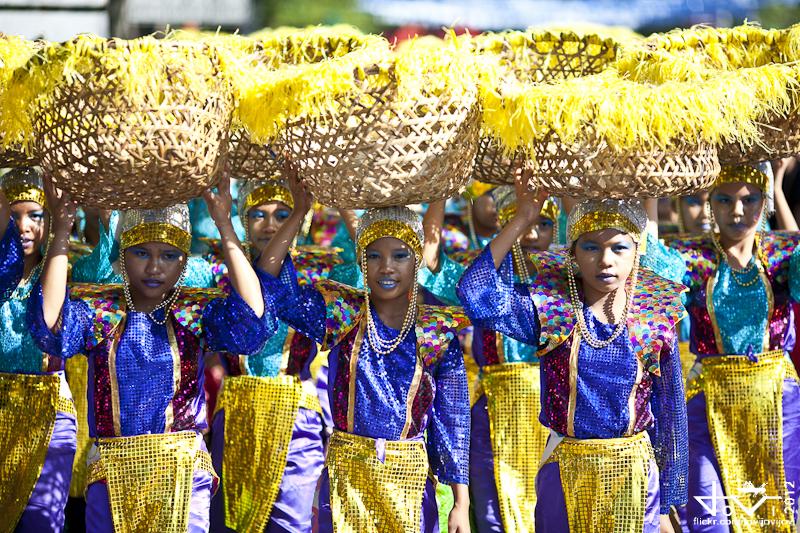
Kadayawan 2012: Street Dancing (Indak-Indak)
The Kadayawan Festival is an annual festival in the city of Davao in the Philippines. It is held during the month of August. Its name is derived from the friendly greeting "Madayaw", from the Dabawenyo word "dayaw", meaning good, valuable, superior or beautiful. The festival is a celebration of life, a thanksgiving for the gifts of nature, the wealth of culture, the bounties of harvest and serenity of living.
KADAYAWAN HIGHLIGHTS
Kadayawan.com presents an amazing guide to the many colorful events involved in the festival:
Opening Ceremonies & Indigenous Peoples Panagtagbo
Dabawenyos start the celebration by conducting a thanksgiving mass for having a bountiful life and harvest. The mass was held on August 3, 2012 about 4:30pm at People's Park Great Lawn, Davao City. The mass was followed by a presentation of the 10 tribes of Davao showcasing their color and culture through music and dance.
Hiyas sa Kadayawan 2012
Hiyas sa Kadayawan is a beauty pageant where local beautiful ladies representing the 10 tribes of Davao will battle for the title of Miss Kadayawan 2012, presenting the respective great tribes of Davao through indigenous garbs, cultural performance, interview and indigenous attire.
The talent night was held on August 15, 2012, Wednesday, 6pm at Gaisano Mall of Davao and the grand finals was held on August 17, 2012, Friday, 6pm at the Davao City Recreation Center.
Indak-Indak sa Kadalanan
One of the highlights of the event was the Indak-Indak sa Kadalanan, a street dance competition where local cultural groups performed. The dance contest was celebrated on August 18, 2012, Saturday, 8:00am.
Some artists joined the parade, riding on a beautiful float.
After the street dance parade around the city particularly from Roxas Avenue to San Pedro Street, the final showdown continued in Rizal Park area.
Pamulak Kadayawan
August 19, 2012, Sunday at 7:00 am, a variety of floral floats was featured in a grand and splendid parade. The parade went around the major roads of the city. The parade was composed of competing and non-competing entries showcasing different kinds of beautiful floats. It is definitely the most awaited event by the locals.
Gallery
Kadayawan Festival 2012







BACKGROUND
Origins
It was said that, long time ago, Davao's ethnic tribes residing at the foot of Mount Apo would converge during a bountiful harvest. This ritual serves as their thanksgiving to the gods particularly to the “Manama” (the Supreme Being).
Various farming implements, fruits, flowers, vegetables, rice and corn grains were displayed on mats as villagers give their respect and thanks for the year's abundance. Singing, dancing and offerings to their divine protectors are the highlights of this ritual.
Although times have changed, this practice of thanksgiving or "pahinungod" is still very much practiced by modern day Davaoeños. This tradition flourished and evolved into an annual festival of thanksgiving.
In the 1970’s, Mayor Elias B. Lopez, a Bagobo, initiated tribal festivals featuring the Lumad and the Muslim tribes of Davao City where they showcase their dances and rituals of thanksgiving.
Later in 1986, a program called "Unlad Proyekto Davao" was initiated by the government which was aimed to unite the Dabawenyos after the turbulent Martial Law era. At that time, the festival was called "Apo Duwaling," a name created from the famous icons of Davao: Mt. Apo, the country's highest peak; Durian, the king of fruits; and Waling-waling, the queen of orchids.
“Apo Duwaling” was meant to showcase the city as a peaceful destination to visit and to do business after the 1986 EDSA Revolution.
Finally in 1988, City Mayor Rodrigo Duterte renamed the festival as "Kadayawan sa Dabaw" to celebrate the bountiful harvest of Davao’s flowers, fruits and other produce as well as the wealth of the city’s cultures. To this day, the festival continues to honor the city's richness and diverse artistic, cultural and historical heritage in a grand celebration of thanksgiving for all of Davao City's blessings.
10 Tribes
The City of Davao has ten native tribes, such as Ata, Matigsalug, Ovu-Manuvo, Klata-Djangan, Tagabawa, Tausog, Maguindanao, Maranao, Kagan, and Sama.
The Kadayawan Today
Today, Kadayawan has transformed into a festival of festivals, with a number of spin-off festivals in the region. The festival honors Davao’s artistic, cultural and historical heritage, its past personified by the ancestral Lumad people, its people as they celebrate on the streets, and its floral industry as its representatives parade in full regalia in thanksgiving for the blessings granted on the city. A celebration that interfaces the three aspects: tribal; industrial and; arts and entertainment. The festivities are highlighted with floral floats, street-dancing competitions and exhibits that showcases the island's tourism products and services.
Today, the recognized original tribes of Davao are here for political reasons. They are recognized because of their present day influence since they have organized themselves well. They are given deputy mayors to be their representatives to the political powers of Davao City. The present tribes of Davao is not based on historical accounts of the original inhabitants at all. They have removed the Mansakas and Mandayas from the list and replaced them with the Muslim tribes like Maranao, Tausug, and Maguindanao. Their reason is Mansaka is from Davao del norte and Mandaya is from Davao Oriental. What they didn't notice is the places they said have "Davao" in their names while the Maguindanaos, Tausugs and Maranaos are obviously not from a place called Davao. What is more ironic is that Mandaya and Mansaka have the word "MADAYAW" in their dialects from which the "Kadayawan Festival" is derived.
If the tribes are recognized because of their present numbers in a city then the Muslim tribes(especially the Maranaos) must have been also recognized as original tribes by other cities and municipalities since they are found in numbers in every city and municipality in the Philippines.










